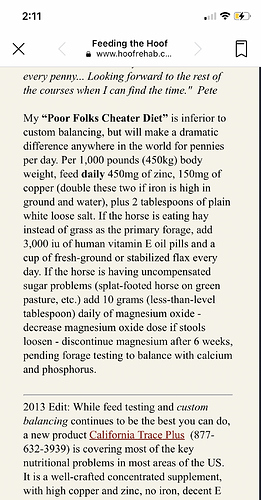www.equi-analytical.com is a great place to test hay. The 601 test is all most people need (603 if you’re trying to dial in metabolic diets)
Some county extension agencies do forage testing, but IME many of those only do bare bones basic testing, not including trace mineral testing. Some allow you to add that on to the basic, but even then, IME the cost ends up right at or higher than the 601 E-A test, so you might as well start with the better one.
I don’t recommend testing grass, as sugar/starch levels change throughout the day, nutrient levels change with seasons and even different parts of the pasture.
You start with the hay analysis, if that’s an option. Lots of people can’t test their hay because whether they board or keep at home, they don’t have enough of a single supply to warrant it.
If you have your forage analysis, then you start there. You don’t even need a FeedXL subscription, you can plug numbers in here. Use the top tabs to put in the details of your horse (Animal Specifications) , your feed info (Dietary Supply) and work your way across.
Nutrient Requirements of Horses - Working Doc (nationalacademies.org)
As far as choosing a supplement to fill in the gaps, that entirely depends on the gaps. A ration balancer may do a very good job - pick one available to you, plug in the numbers you’d get from a proper serving, and see what you get. Sometimes you only need copper and zinc, and those can be supplemented separately.
It is and isn’t. 2 1000lb horses in moderate work still have the same nutritional needs, even if their calorie needs are very different. Their calorie needs, or any food sensitivities, would then the be the individual requirements in filling nutritional gaps or imbalances.
Keep in mind its shortcomings. If you don’t have YOUR forage to input, it’s as generic as the average forage it will use. Its output is only as good as the info it has for the supplements/feeds you say you use. It will tell you the horse is deficient in the B vitamins your horse is almost guaranteed to be making on his own.
It’s best feature, which the NRC working doc (above) doesn’t do, is try to recommend a supplement to fill the gaps it sees, but IMHO that’s not worth paying for.
Generally, yes, but that doesn’t mean the horse has an issue. There are some areas where selenium is either really high (many areas of CO), or really low, BUT, you need to do blood work to see where your horse is, on his diet before making any addition/removal decisions.
There are a few areas where grass doesn’t provide enough Vit E, but again - blood work first.
Soil analysis tells you how to fertilize for optimally healthy grass.
Hay analysis tells you how to feed/supplement for an optimally healthy horse.



